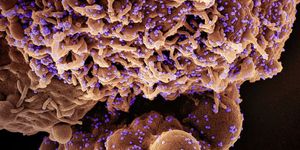Transcription Factors Can Bind RNA & Have a Big Impact
Transcription factors are an essential part of gene expression. Some of these proteins are known as master regulators, and they can have an impact on many different biochemical pathways and processes in cells. Transcription factors can increase and decrease gene expression, and sometimes work with protein partners to do so; they tend to have an end that can bind to DNA and another end that can attach to proteins. Researchers have now shown that transcription factors can bind to RNA as well, and that attachment has significant impacts on gene expression. The findings have been reported in Molecular Cell.
When a gene that encodes for protein is active, it is transcribed into RNA, which is then translated into protein by cellular machinery. This work showed that when transcription factors bind to RNA molecules, they are kept close to the genetic site, where they bind to influence gene expression for a longer period of time. This probably enables fine control of gene expression.
This new information about how transcription factors work may have implications for RNA-based therapeutics, and has broadened our understanding of how genes activity is regulated. Previous work has shown that transcription factors can bind to RNA molecules, but this study has shown it's not just a glitch or artifact when that happens. This research has suggested that half of all transcription factors or more can bind to RNA.
"We show that RNA binding by transcription factors is a general phenomenon. Individual examples in the past were thought to be exceptions to the rule. Other studies dismissed signs of RNA binding in transcription factors as an artifact, an accident of the experiment rather than a real finding," explained postdoctoral researcher and first study author Ozgur Oksuz. "The clues have been there all along, but I think earlier work was so focused on the DNA and protein interactions that they didn't consider RNA."
The portion of transcription factor proteins that can bind to RNA, its so-called binding domain, is unlike other RNA binding domains. As such, researchers had not identified it before, and it was not predicted with current tools.
The human immunodeficiency virus (HIV) is known to encode for a protein called Tat that is like a transcription factor. The expression of the HIV genome is promoted by Tat, which binds to viral RNA, then brings cellular machinery to it. The RNA binding site of Tat is unusual; it contains an arginine-rich motif (ARM). The researchers decided to look for human transcription factors that had any sequence similarities to Tat. Indeed, they found ARMs in many human transcription factors, and the transcription factors of many other organisms. Then they showed that these ARMs attach to RNA.
Additional work confirmed that the ARMs helped transcription factors function normally; without them, transcription factors were not as good at finding their target sites, staying in place, and regulating gene expression. In a zebrafish model, the loss of an ARM in a transcription factor caused major developmental defects.
When the investigators searched through genetic mutations that influence cancer and heritable diseases, they saw that some of the mutations arose in the RNA binding regions of transcription factors. RNA binding appears to be crucial to how transcription factors function.
"With evidence that RNAs can tune gene expression through their interaction with positive and negative transcription factors, we can envision using existing RNA-based technologies to target RNA molecules, potentially increasing or decreasing expression of specific genes in disease settings," noted postdoctoral researcher and study co-author Jonathan Henninger.
Sources: Whitehead Institute for Biomedical Research, Molecular Cell









